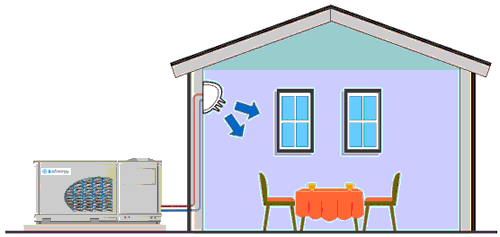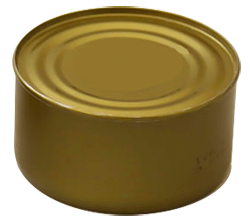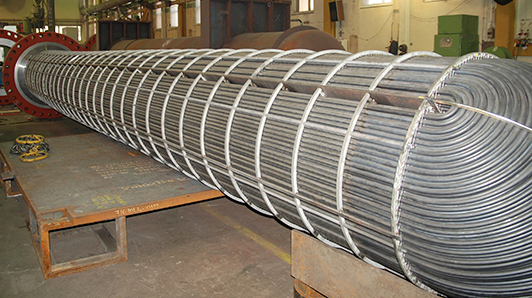 The Phase Change Matters e-mail newsletter is a weekly summary of the latest news and research on phase change materials and thermal energy storage. To subscribe, visit www.puretemp.com/subscribe. For more frequent updates, follow @puretemp on Twitter or visit the Phase Change Matters blog, www.puretemp.com/pcmatters.
The Phase Change Matters e-mail newsletter is a weekly summary of the latest news and research on phase change materials and thermal energy storage. To subscribe, visit www.puretemp.com/subscribe. For more frequent updates, follow @puretemp on Twitter or visit the Phase Change Matters blog, www.puretemp.com/pcmatters.
NEW PRODUCTS

Ice Bear 20 cooling system is aimed at residential market
Ice Energy of Glendale, Calif., has introduced a smaller version of its commercial Ice Bear thermal energy storage system. The new Ice Bear 20 has a 265-gallon tank and a thermal storage capacity of 240,000 BTUs. During off-peak hours, the Ice Bear stores cooling energy by freezing water in an insulated tank. During peak hours, the company says, the stored ice delivers up to four hours of cooling, reducing the typical peak load by 95 percent.
“The Ice Bear 20 is a uniquely cost-effective, reliable and green energy storage system that transforms residential AC load into a clean, flexible and responsive grid resource for utilities while providing cooling comfort for homeowners,” said Mike Hopkins, CEO of Ice Energy. “It incorporates the same technology as our proven Ice Bear 30, with the added benefit of an integrated cooling and storage system. With Ice Bear 20s and Ice Bear 30s in place, almost any part of the grid with peak demand or solar over-generation issues can be reliably and cost-effectively addressed by utilities, all while reducing CO2 emissions.”
The Ice Bear 20 will be on display Feb. 9-11 at DistribuTECH 2016 in Orlando, Fla.
CanVesl added to Vesl line of PCM containment devices
 In partnership with Entropy Solutions, Vesl LLC has added CanVesl to its line of PCM containment devices.
In partnership with Entropy Solutions, Vesl LLC has added CanVesl to its line of PCM containment devices.
These sturdy metal PCM devices are able to withstand great temperature extremes. They are hermetically sealed to prevent moisture and vapor transmission. The coated steel resists corrosion. Each can holds 160 grams (5.6 ounces) of PureTemp phase change material, available in a wide range of temperatures, from -37°C (-34°F) to 151°C (304°F).
PATENTS
Climate control system with phase change material
U.S. patent application 20160033207 (applicant BuroHappold Engineering, Bath, England):
“A climate control system includes a closed vessel containing a phase change material for absorbing heat from or emitting heat to an environment in which the system is intended to be arranged. The closed vessel also contains a solid heat conducting medium for facilitating heat transfer within the vessel. …
“[A] characteristic of the phase change material is that it changes state at a peak melt temperature within the range of 18° C. to 26° C. … wherein the phase change material is a mixture of paraffin and hydrated salt.”
IN BRIEF

• POWER magazine’s Aaron Larson takes a look at the latest innovations in heat exchanger technology. Expanded metal baffle designs, such as the one shown above from EMbaffle B.V., promise better heat transfer and eliminate flow-induced vibration.
• Esquire magazine selected Ember Technologies’ temperature-adjustable mug, powered in part by phase change material, as one of the top five gadgets among the thousands displayed at last month’s Consumer Electronics Show in Las Vegas.
• German researchers are developing a PCM-based thermal energy storage system using salt hydrates and hybrid double-shell concrete tanks. The goal is to convert excess electricity from renewable sources and store it as heat for use in a single building or shared in a smart grid of neighborhood buildings.
• “New phase change material is improving packout efficiencies with higher latent heat,” UPS cold chain strategist Susan Li says in an interview with Contract Pharma. “However, cost is still an issue to further advance the application of such technology.”
• NASA is testing microencapsulated phase change material as a coating to dissipate heat generated during supersonic flight. In a four-year study at the Marshall Space Flight Center in Alabama, the coating proved to be unaffected by ultraviolet rays and produced no residue or side effects.
• South African researchers say graphite foams may be the key to capturing and storing thermal energy from solar farms, Materials Today reports.
• Global palm oil production is expected to be lower in 2016 than forecast due to the El Niño phenomenon, the Malaysian Palm Oil Council said Tuesday. The council projects an average price of $621 per metric ton and says the price is not likely fall below $480.
• CIC Energigune, an energy research center in Spain’s Basque Country, has an opening for a lab technician in its thermal energy storage group.
• Johnson & Johnson and va-Q-tec Ltd. won first-place awards at the annual temperature controlled logistics conference in Frankfurt last month. Katharina Wuensche, va-Q-tec’s director of business development, won the Cold Chain IQ Newcomer Award.
• Among cold chain specialist Gary Hutchinson‘s predictions for 2016: Specialized packaging for specific drugs and tighter controls on clinical trial operations in extreme environments.
• In an interview with Health Care Packaging, cold chain consultant Geoff Glauser talks about the challenges of transporting and storing the Ebola vaccine in West Africa. Intellectual Ventures‘ Arktek passive cooling device was adapted for use in clinical trials of the vaccine, using a specially formulated phase change liquid that freezes at -80º C.
COLD CHAIN
Standardized practices help reduce spoilage, packaging waste
 As Cardinal Health‘s quality systems director, Chris Anderson understands the complexities of shipping temperature-sensitive medical products around the world. Since 2007, he has been instrumental in developing standardized cold chain practices to reduce spoilage and cut packaging waste.
As Cardinal Health‘s quality systems director, Chris Anderson understands the complexities of shipping temperature-sensitive medical products around the world. Since 2007, he has been instrumental in developing standardized cold chain practices to reduce spoilage and cut packaging waste.
Pharmaceutical Commerce magazine takes a close look at the evolving relationship between Cardinal Health and Sonoco ThermoSafe, which uses PureTemp phase change panels to provide temperature-specific cooling in totes shipped to local pharmacies:
“Data Anderson collects shows that the PureTemp panels would be cost-effective if they could be reused at least eight times. As of 2015, the PureTemp panels are actually being reused as many as 87 times—a 10X rate above break-even. Spoiled product returns have been cut by 85%—and this is over a period where the volume of cold chain product grew by 50%, now approaching $21 billion per year.”
RESEARCH ROUNDUP
For our full list of recent academic research, see puretemp.com/academic. Here are highlights from the past week:
From Fire Safety Journal:• Experimental investigation of the fire resistance of multi-layer drywall systems incorporating Vacuum Insulation Panels and Phase Change Materials
From Applied Thermal Engineering:
• Thermal analysis of Phase Change Material Board (PCMB) under weather conditions in the summer
• Experimental study on natural convective heat transfer of tube immersed in microencapsulated phase change material suspensions
• Experimental assessment of a phase change material storage tank
From Building and Environment:
• Phase change material’s (PCM) impacts on the energy performance and thermal comfort of buildings in a mild climate
From Engineering in Agriculture, Environment and Food:
• On the Use of Encapsulated Phase Change Materials Pebbles and Pellets as Freeze Protection Method for Low-Stature Plants/Crops
From Energy:
• Thermal performance enhancement of palmitic-stearic acid by adding graphene nanoplatelets and expanded graphite for thermal energy storage: A comparative study
From Solar Energy:
• Fabrication and properties of microencapsulated n-octadecane with TiO2 shell as thermal energy storage materials
• Synergistic enhancement of thermal conductivity for expanded graphite and carbon fiber in paraffin/EVA form-stable phase change materials
From Energy and Buildings:
• Thermal performance assessment of encapsulated PCM-based thermal management system to reduce peak energy demand in buildings
• Thermal Performance Investigation and Optimization of Buildings with Integrated Phase Change Materials and Solar Photovoltaic Thermal Collectors
From Materials and Structures
• Use of phase change material to improve thermal properties of lightweight geopolymer panel
NETWORKING
Connect with PCM experts and industry leaders on LinkedIn
Nearly 600 of your peers have joined a new LinkedIn group devoted to the discussion of phase change material and thermal energy storage. The Phase Change Matters group is an interactive complement to the award-winning blog and newsletter of the same name.
You are invited to join the group and connect with PCM and TES experts from around the world. Akshayy Garg, a product designer at India’s Laser Science & Technology Centre in New Delhi, is one of the group’s newest members. He is looking for help with a thermal conductivity problem. He writes:
We are developing high wattage TES for 1 kW of capacities using finned-tube HX. But problem we are facing is low thermal conductivity of Organic type of PCM (0.2 W/m.K). We are looking into solutions like micro-encapsulation etc. so that we can increase thermal conductivity.
We require following composites PCM:
• Thermal conductivity of composite 5 W/m.K or more
• Density of PCM 1400 kg/m3 or more
• Latent heat of PCM 150 kJ/kg or more
• Percentage of PCM (by mass) More than 65%
Here’s a link to the discussion:
https://www.linkedin.com/groups/6953237/6953237-6101117982308655106
YOUR TURN
Got a question about PCMs or TES? Ask our experts
Entropy Solutions’ PCM experts are ready to answer your questions about phase change material and thermal energy storage. We’ll select the best questions sent to bwelter@puretemp.com and post the answers here each Friday.
John A. Murphy asks:
“What are the health concerns with PCM consumer products such as comforters, blankets, vests and caps? Are VOCs involved in the encapsulation of various materials used for these temperature ranges? Are there test results for vapor samples collected in the headspace of these materials while in use? When paraffins are used are they mobile in the fibrous material and present in the surface of the product? Are the vegetable origin compounds used mixed with solvents in the manufacture of these products?”
Our experts say:
“In order for PCMs to be incorporated into consumer products such as comforters, blankets, vest and caps they must first be microencapsulated. Once microencapsulated, the capsules are then embedded into the fibers of these items. There are numerous microencapsulation companies across the world that use their own specialized method to microencapsulate PCMs. During the microencapsulation process, a shell is formed around the PCM. Once encapsulated the PCM itself becomes contained and is no longer able to become volatile unless the microsphere is ruptured. Any detectable VOCs after containment is usually dependent upon the materials of the shell and not the PCM. Usually VOCs associated with microspheres are from residual PCM that was not microencapsulated, ruptured microspheres or residual monomers from the polymer shell. The method of microencapsulation and chemicals used varies from company to company, therefore the use of VOCs is process and company dependent.”